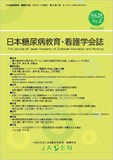Japanese
English
- 販売していません
- Abstract 文献概要
- 参考文献 Reference
本研究の目的は,インスリン使用高齢糖尿病患者の血糖コントロール目標値設定の様相を明らかにすることである.対象者10名に半構成的面接を行い,修正版グラウンデッド・セオリー・アプローチを用いて分析した.
その結果,23概念から生成された7カテゴリーと4概念によってプロセスが描かれた.【自らの意思で日々努力する療養生活】を基盤とし,≪初期は低めのHbA1c 目標値設定≫であった.≪主治医との信頼関係の上で共に取り組む療養≫が故,歳を重ねて【戸惑いながらも受け入れようとする緩和された年相応のHbA1c目標値】と捉えていた.しかし【根底では捨てきれない理想のHbA1c目標値】が拮抗していた.その拮抗には≪細かい理解はできていないHbA1c目標値の変更≫が影響していた.また捨てきれない理想の目標値には【分かっているようで分からない低血糖の怖さ】が影響していた.
以上より,医療者は患者の捉え方を理解し,インスリン使用高齢糖尿病者にとって安全な目標値設定を共に考え支援していくことが必要であると示された.
This study aimed to clarify aspects of setting blood glucose targets for older adult patients with diabetes using insulin. We conducted semi-structured interviews with 10 patients and analyzed data using the Modified Grounded Theory Approach(M-GTA).
As a result, the structure was described using seven categories and four concepts, generated from 23 initial concepts. Based on the idea of[ a life of medical treatment in which one makes daily efforts based on own will], <initially, a low HbA1c target value was set>. Moreover, because the <medical treatment was carried out together with the attending physician based on a trusting relationship>, as patients aged,[ although confused, patients thought of substituting their HbA1c target value for a more relaxed, age-appropriate one]. However, this was antagonized by[ the optimal HbA1c target value that cannot be abandoned ], and this antagonism was influenced by <changes in HbA1c target values, which were not fully understood>. Furthermore, [the fear of hypoglycemia, which patients seemed to know but not understand], influenced the optimal target values that they could not abandon.
The findings highlight the need for medical professionals to endeavor to understand how patients perceive their target blood glucose values. The results suggest they must collaboratively consider and support setting safe blood glucose targets in older adult patients with diabetes requiring insulin therapy.
Copyright © 2024, Japan Academy of Diabetes Education and Nursing. All rights reserved.


